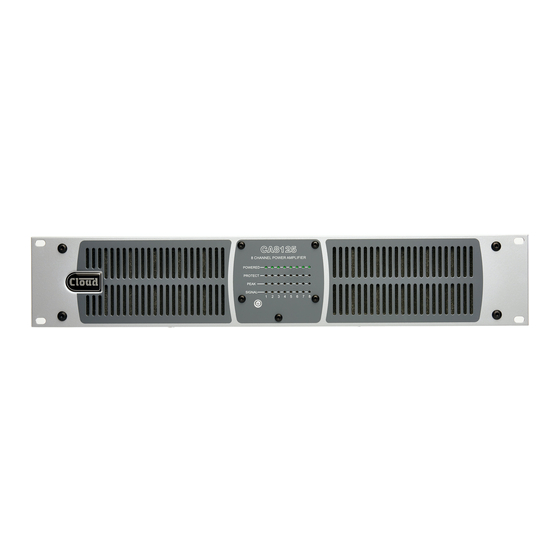Cloud CA2500 Technisches Bulletin - Seite 10
Blättern Sie online oder laden Sie pdf Technisches Bulletin für Kontrolleinheit Cloud CA2500 herunter. Cloud CA2500 13 Seiten.
Auch für Cloud CA2500: Installations- und Benutzerhandbuch (19 seiten)

5. At this stage, the PSU module is electrically isolated from the rest of the amplifier circuitry and can be
removed, by turning the amplifier upside-down, and unscrewing the 4 M3 machine screws which go
through the chassis base and into the PSU. The PSU will then simply drop out, with its aluminium
baseplate intact.
Note: do not remove the Torx screws from the top side of the PSU, as this will separate the PSU from its
baseplate, and is not the correct way to remove the it from the chassis. The replacement PSU will be
supplied with its own baseplate pre-fitted.
The procedure for replacing and re-connecting a PSU module, is the reverse of this process:
1. Screw the PSU into the chassis, using the 4off M3 machine screws.
2. Connect the 15-pin, low-voltage DC supply and control connector.
3. Connect the 4 pin, high-voltage DC supply connector.
4. Connect the 3 pin, AC mains input connector.
Procedure for Diagnosis and Replacement
1. Prior to making a diagnosis, make a note of which protect LEDs are illuminated, and then remove mains
power from the amplifier. Leave the amplifier to stand for a minute to let the power supplies discharge as
much as possible.
2. Disconnect all speaker loads from the rear connections of the amplifier, making a note of which
connection is for which amplifier, so that the speakers can be correctly re-instated later.
3. The amplifier chassis lid should be removed, and a visual check made that all cable loom connectors are
securely seated in their respective sockets and are making proper connection. These are:
3.1. CA2250:
3.1.1. 1off multi-conductor, black, cable loom from PSU1 to the main PCB
3.1.2. 1off multi-tapped, high-voltage power cable from PSU1 and feeding each amplifier module, as
well as feeding the high-voltage fan circuit on the main PCB
3.1.3. 1off speaker output cable loom
3.2. All other models:
3.2.1. 2off multi-conductor, black, cable loom from PSU1 and PSU2 to the rear and front main PCBs,
respectively.
3.2.2. 2off multi-tapped, high-voltage power cable from PSU1 to the odd numbered amplifier modules
(1, 3, 5, 7) and from PSU2 to the even-numbered amplifier modules (2, 4, 6, 8). Both of these also
feed the high-voltage fan circuit on the front PCB. Note that on amplifiers featuring fewer than 8
channels, some of the taps on this high-voltage cable may be tied-off as they are not required.
3.2.3. 2off speaker output cable loom, connecting the amplifier modules to the rear-panel speaker
output PCB.
4. A visual inspection should be made at this point, looking for evidence of bulging, domed, or burst
capacitors, or other obvious signs of failure, on the amplifier channel modules and PSUs. Do not touch the
